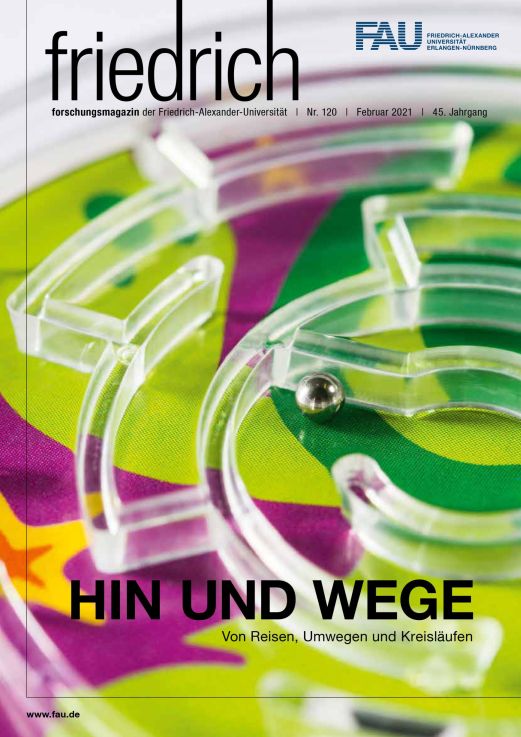Next stop: the unknown
Globalisation, contact restrictions, quarantine – a lot of what we are experiencing in conjunction with the coronavirus is not new, say medical historians. What has changed considerably is how we map and forecast how the disease spreads – an aspect IT experts, mathematicians and engineers are currently getting to grips with.
The coronavirus pandemic is ever present. Covid-19 is not a storm that will blow over and then leave us in peace. Even if it seems unlikely for the moment that the virus will spread uncontrollably as we have an effective vaccine and we know more about the impact of protective measures, we will still ask ourselves: When will the next pandemic come? And how can we prepare for it?
Questions that affect the future are best answered by looking back into the past. Historical developments show that neither global spread nor radical defence responses are exclusive to the present day. ‘Epidemics have occurred throughout the whole of human history,’ says Professor Karl-Heinz Leven. ‘And they have instilled fear and anxiety for thousands of years.’
Globalisation is not a modern phenomenon
Leven is Director of FAU’s Institute of the History of Medicine and Medical Ethics. He is highly familiar with the history of infectious diseases, where they occur, how they spread, how people react to them. That travelling microbes are part and parcel of globalisation is not as new as we often believe. ‘The Justinian plague in the middle of the sixth century came to Europe via trade routes, just as the Black Death did at the end of the Middle Ages – one of the worst catastrophes ever to afflict Europe,’ says Leven. However, diseases were also transported in the opposite direction: Smallpox and measles, for example, until epidemics that were endemic to Europe made their way to America with the voyages of Columbus and other conquerors. This led to explosive epidemics which still affect the Native Americans today.

In Europe, smallpox was first contained and then kept under control through successful immunisation – inoculation with cowpox – at the beginning of the 19th century. Despite all efforts, it is today the only contagious disease that could be eradicated by means of a vaccine. But new epidemics followed: In the 19th century, Europe was plagued by four cholera epidemics and in 1918 the Spanish flu killed up to 50 million people. ‘Despite this large number of victims, average mortality was only between 0.5 and 2.5%,’ says Leven. ‘Lots of people fell ill, but most of them survived.’ In the middle of the 20th century, the Asian flu and the Hong Kong flu were pandemics which, looking back, are reminiscent of the Spanish flu. Leven: ‘From an epidemiological standpoint, Covid-19 belongs to this group. We should not expect that it is the last that we will see of this type of viral pandemic.’
Time for the authorities to act
The battle against epidemics is as old as the diseases themselves and outbreaks have been explained throughout history by belief systems prevalent at the time: In the pre-modern era, epidemics were often interpreted as divine punishment or trials of affliction. People tried to avert the threat by means of rites, penance and penitential processions. The miasma theory, which held that bad air was the cause of disease, offered first natural history approaches. However, burning incense could do little to thwart the pathogens. It was during the plague epidemics in the course of the Middle Ages that really drastic measures were introduced: Towns and cities were cleaned of faeces and animal waste. This was accompanied by quarantine, the 14-day isolation of ships, crews and goods from foreign ports. Infected individuals in the towns and cities themselves were isolated in their houses and kept under surveillance or else confined to special plague houses. Stringent plague regulations were drawn up and enforced through coercion and punishment.
When epidemics and pandemics occur, it is time for the authorities to act. This is also clear to see in the case of the coronavirus: ‘Compared with the outbreaks of epidemics in the course of history, but also with current communicable epidemic and pandemic diseases, the infection and mortality rate of Covid-19 is low,’ says Karl-Heinz Leven. ‘Nevertheless, reactions to the threat posed by the coronavirus are dramatic, even historically unique. This is due in part to public perception of certain contagious diseases which is highly emotionalised and reinforced by the media,’ he adds. It can nonetheless be hailed as a success that in the middle of 2020 the epidemic could be effectively contained in many places through radical lockdowns. After all, like in the history of other epidemics, there is no specific cure for Covid-19. ‘The widespread belief that a vaccine will soon allow us to return to normality is likely to be an illusion,’ says Leven. ‘We’re going to have to live with a new normal.’
Knowledge of pathogens leads to the foundation of mathematical epidemiology
With new findings above all in microbiology and bacteriology at the end of the 19th century, disease transmission ceased to be a mystery. The possibility to identify routes of infection was at the same time the foundation for mathematical epidemiology: In 1927, British scientists Anderson Gray McKendrick and William Ogilvy Kermack developed a model with which they were able to reconstruct – with astonishing precision – a plague epidemic that had occurred 20 years earlier in Bombay, India. The central element of their theory is the division of the population into different groups: Susceptible people (S), that is, healthy individuals predisposed to contracting a disease, infected individuals (I) and individuals who have been removed from the disease (R) and either developed an immunity or else died.
Even today, this SIR model still forms the basis for epidemiological models, now mostly extended to include the group of exposed individuals who have contracted the disease but themselves are not yet infectious. Using differential equations, it is possible to calculate, for example, the maximum number of infected individuals there will be at the same time, when this peak will be reached and the total number of people who will contract the disease. ‘SIR models with varying parameters of infectivity are particularly useful in the cases of diseases which we know very little about at the time of the outbreak,’ says Dr Sebastian Meyer from FAU’s Institute of Medical Informatics, Biometry, and Epidemiology.

Statistical models need good data
Meyer ranks among the leading German experts as far as statistical models of the temporal and spatial spreading of communicable diseases are concerned. He has developed data-based methods to help estimate spread dynamics and the effects of containment measures. Here, he also draws on dynamic spatial point processes that are used, for example, to predict tectonic aftershocks. Meyer is making his statistical methods available for epidemiological research with his R Package ‘Surveillance’. He is substantially involved in the development of this open source statistics software, which the Robert Koch Institute also uses.
Statistical models are, however, only as good as the data fed into them. Firstly, these are case numbers from the epidemiological monitoring of reportable communicable diseases. Information about the disease itself, i.e. infectivity, incubation period, duration and severity of disease progression or the virulence of pathogens depending on season and weather, plays an important role in modelling. Secondly, sociodemographic variables must be taken into account: How does population mobility affect different regions? How are age groups distributed? What is the immunisation status for existing diseases? What role does social contact play – are people more sociable or rather restrained? And finally, the effects of infection prevention measures have to be included in the calculations, for example school closures, banning large events or wearing masks on public transport and in shops. However, the availability of such data for the simulation of dynamic infection processes is often inadequate:
‘In comparison to weather forecasts, predicting epidemics is still in its early days,’ says Meyer.
Electronic reporting systems could help to close the data gaps: In the USA, for example, the Department of Health and Human Services launched an initiative some years ago to better predict epidemics. Through this systematic cooperation between health authorities and research institutes, predictions of how flu will spread are becoming better and better. More recently, Google searches, Wikipedia hits and Twitter messages have also been included as data in their models. ‘Intense competition between research groups for the most reliable model has broken out here,’ says Meyer.
SIQRD model takes quarantine into consideration
The dynamics of the coronavirus pandemic have meanwhile triggered a competition for reliable simulation models in Germany too. A large number of working groups have joined forces at FAU as well – and even in disciplines not usually associated with epidemiological research. For example, researchers at the Chair of Applied Mechanics (LTM) have started to simulate the spread of Covid-19 across smaller geographical areas – partly even down to the level of districts and towns. Normally, the researchers are busy trying to find out how metals, polymers or biomaterials behave under the influence of mechanical forces. ‘In such experiments, we investigate how changing one parameter effects another,’ explains Professor Paul Steinmann, who heads the institute. ‘Simulating the spread of a virus is not fundamentally different.’

Together with Dr Silvia Budday, Steinmann has chosen a new approach for modelling the spread of Covid-19. Although their research also builds on the SIR model, it considers an additional aspect of infection rates: ‘We differentiate between asymptomatic cases or cases with mild symptoms, which make up most of the new infections, and people with noticeable symptoms,’ explains Steinmann. ‘This differentiation is based on the assumption that known cases are quarantined and can no longer infect others.’ In collaboration with Dr Lukas Pflug from FAU’s Institute of Applied Mathematics, Steinmann and Budday have extended their SIQRD model, which records the groups of susceptible people (S), infected persons (I), those in quarantine (Q), people who have recovered (R) and those who have died (D), to include what is known as an integrodifferential approach. This approach makes it possible to directly incorporate medical data on disease progression – such as new knowledge about the incubation period and disease duration, transmission routes or the analysis of risk groups.
Model zooms down to local level
The research team aimed to use their model to predict the outbreak dynamics of Covid-19 in the smallest possible geographical units, for example, in order to facilitate better coordination of ambulance services or ICU bed capacity. In their investigation, they recorded different contact restriction measures from region to region and also integrated sociodemographic data into their model. ‘Habits and mindsets seem to have an influence on differing infection rates that is far from negligible,’ explains Silvia Budday. ‘This has also been discussed when comparing European countries, such as Germany and Italy.’ When zooming down to regional level, it was also clear that larger towns and cities play a far greater role in the spread of Covid-19 than movement across regional borders.
Interview with Prof. Enrique Zuazua
Enrique Zuazua is Humboldt Professor for Applied Analysis at FAU. As an expert in wave propagation, he is also studying the dynamics of the coronavirus pandemic. Read the interview with Prof. Zuazua.
A retrospective comparison with the figures published by the Robert Koch Institute shows that the SIQRD model can predict the development of infections at local level with sufficient accuracy. However, there were also deviations – some more rural places, such as Tirschenreuth in the Upper Palatinate, in reality reported a far higher level of infections than was simulated in the model. ‘We put such local, over-proportional case numbers down to more random superspreading events, which can occur at any time but are hard to predict,’ explains Steinmann. Nonetheless the researchers in Erlangen are convinced that their model can help political decision-makers to develop effective strategies to contain the disease, plan capacities in the healthcare sector and thus avoid further lockdowns.
About the author
Matthias Münch studied sociology before working as a freelance journalist for several daily newspapers. Since 2001, he has been providing support for companies and academic institutions in the areas of PR and corporate communication.
FAU research magazine friedrich
 This article first appeared in our research magazine friedrich. You can order the print issue (only available in German) free of charge at presse@fau.de.
This article first appeared in our research magazine friedrich. You can order the print issue (only available in German) free of charge at presse@fau.de.
